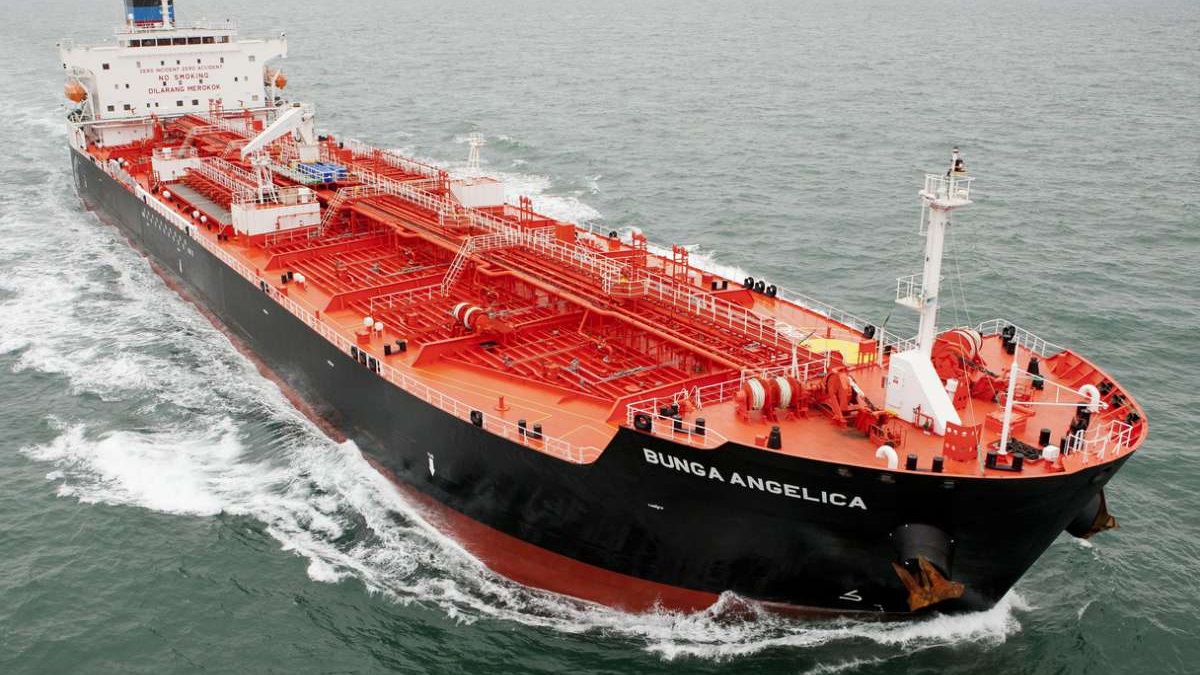Types Of Ships
The great majority of ships that are neither military vessels nor yachts can be divided into several broad categories: cargo carriers, passenger carriers, industrial ships, service vessels, and noncommercial miscellaneous. Each category can be subdivided, with the first category containing by far the greatest number of subdivisions.
Service vessels
The service ships are mostly tugs or towing vessels whose principal function is to provide propulsive power to other vessels. Most of them serve in harbours and inland waters, and, because the only significant weight they need carry is a propulsion plant and a limited amount of fuel, they are small in size. The towing of massive drilling rigs for the petroleum industry and an occasional ocean salvage operation (e.g., towing a disabled ship) demand craft larger and more seaworthy than the more common inshore service vessels, but oceangoing tugs and towboats are small in number and in size compared with the overwhelmingly more numerous cargo ships.
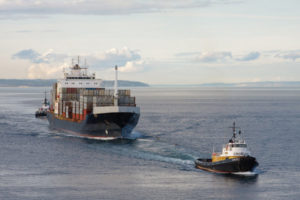
The Horizon Tacoma was a few miles north of Neah Bay when it elected to shut down its main engines following the engine problem, though it continued to have full use of its thrusters and directional navigation. After notification by the U.S. Coast Guard (USCG), the Hunter rapidly got underway and arrived at the ship in less than 30 minutes where it immediately connected a towline.
The state has contracted to station a standby emergency response tug at Neah Bay since spring 1999. The tug has stood by or assisted 44 vessels that were disabled or had reduced maneuvering or propulsion capability while transporting oil and other cargo along the coast and through the Strait of Juan de Fuca. The actions helped ensure the ships didn’t drift onto rocks and spill oil.
A second tug was ordered by the USCG to meet the Hunter at Port Angeles for further assist en route to Tacoma. While the Hunter has the Horizon Tacoma under tow, Crowley has sent tug Valor to stand by in its place.
Miscellaneous
The word miscellaneous has only small scope here. It is intended to encompass classifications such as icebreakers and research vessels, many of which are owned by government. Neither type need be of large size, since no cargo is to be carried. However, icebreakers are usually wide in order to make a wide swath through ice, and they have high propulsive power in order to overcome the resistance of the ice layer. Icebreakers also are characterized by strongly sloping bow profiles, especially near the waterline, so that they can wedge their way up onto thick ice and crack it from the static weight placed upon it. To protect the hull against damage, the waterline of the ship must be reinforced by layers of plating and supported by heavy stiffeners.
Damage to propellers is also an icebreaking hazard. Propellers are usually given protection by a hull geometry that tends to divert ice from them, and they are often built with individually replaceable blades to minimize the cost of repairing damage. Electric transmission of power between engines and propellers is also common practice, since it allows precise control and an easy diversion of power to another propeller from one that may be jammed by chunks of broken ice.
Research vessels are often distinguished externally by cranes and winches for handling nets and small underwater vehicles. Often they are fitted with bow and stern side thrusters in order to enable them to remain in a fixed position relative to the Earth in spite of unfavourable winds and currents. Internally, research vessels are usually characterized by laboratory and living spaces for the research personnel.
Industrial ships
Industrial ships are those whose function is to carry out an industrial process at sea. A fishing-fleet mother ship that processes fish into fillets, canned fish, or fish meal is an example. Some floating oil drilling or production rigs are built in ship form. In addition, some hazardous industrial wastes are incinerated far at sea on ships fitted with the necessary incinerators and supporting equipment. In many cases, industrial ships can be recognized by the structures necessary for their function. For example, incinerator ships are readily identified by their incinerators and discharge stacks.
Passenger carriers
Most passenger ships fall into two subclasses, cruise ships and ferries.
Cruise ships
Cruise ships are descended from the transatlantic ocean liners, which, since the mid-20th century, have found their services preempted by jet aircraft. Indeed, even into the 1990s some cruise ships were liners built in the 1950s and ’60s that had been adapted to tropical cruising through largely superficial alterations—e.g., the addition of swimming pools and other amenities to suit warm-latitude cruising areas. However, most cruise ships now in service were built after 1970 specifically for the cruise trade. Since most of them are designed for large numbers of passengers (perhaps several thousand), they are characterized by high superstructures of many decks, and, since their principal routes lie in warm seas, they are typically painted white all over. These two characteristics give them a “wedding cake” appearance that is easily recognizable from great distances. Closer examination usually reveals a large number of motor launches carried aboard for the ferrying ashore of passengers. Many cruise ships have stern ramps, much like those found on cargo-carrying roll-on/roll-off ships, in order to facilitate the transfer of passengers to the launches and to serve as docking facilities for small sporting boats.
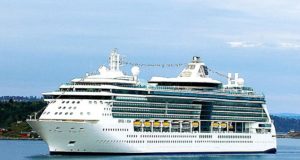
The above features present the principal challenge to the cruise-ship designer: providing the maximum in safety, comfort, and entertainment for the passengers. Thus, isolation of machinery noise and vibration is of high importance. Minimizing the rolling and pitching motions of the hull is even more important—no extreme of luxury can offset a simple case of seasickness. Since cruising is a low-speed activity, propulsive power is usually much lower than that found in the old ocean liners. On the other hand, electrical power is usually of much greater magnitude, mainly because of demands by air-conditioning plants in tropical waters. The typical large cruise ship built since 1990 is powered by a “central station” electric plant—i.e., an array of four or more identical medium-speed diesel engines driving 60-hertz alternating-current electrical generators. This electrical plant supplies all shipboard power needs, including propulsion. Since all power flows from a single source, propulsion power can be readily diverted to meet increased air-conditioning loads while the ship is in port.
Ferries
Ferries are vessels of any size that carry passengers and (in many cases) their vehicles on fixed routes over short cross-water passages. The building of massive bridges and tunnels has eliminated many ferry services, but they are still justified where waters are too formidable for fixed crossings. Vessels vary greatly in size and in quality of accommodations. Some on longer runs offer overnight cabins and even come close to equaling the accommodation standards of cruise ships. All vessels typically load vehicles aboard one or more decks via low-level side doors or by stern or bow ramps much like those found on roll-on/roll-off cargo ships.
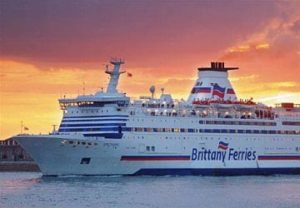
A special type of ferry is the “double-ender,” built for shuttling across harbour waters. The typical vessel has propellers, rudders, control stations, and loading ramps at both ends. It is usually wide enough to handle four vehicle lanes abreast and may accommodate up to 100 four-wheeled vehicles. Special docks, fitted with adjustable ramps to cope with changes in water levels and shaped to fit the ends of the ferry, are always part of a ferry system of this type.
Another special type of ferry is a high-speed vessel that in many cases is of catamaran (twin-hulled) design. This type is typically found on short runs in protected waters where the carriage of vehicles is not required. Catamaran hulls can be narrow and knifelike in shape, allowing them to operate at high speed-to-length ratios without excessive propulsive power. The engines are usually high-speed diesels, although turbine engines have been fitted in a few instances.
Cargo carriers
Cargo ships can be distinguished by the type of cargo they carry, especially since the means of handling the cargo is often highly visible. As noted below (see Cargo handling), the trend is toward specialization in this regard. One consequence is a proliferation in types of cargo vessel. The present discussion is limited to a few types that are represented by large numbers of ships and are distinctive in appearance.
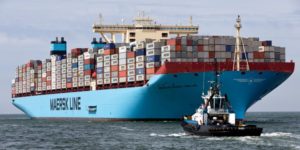
Tankers
Ships that carry liquid cargo (most often petroleum and its products) in bulk are made distinctive by the absence of cargo hatches and external handling gear. When fully loaded they are also readily distinguishable by scant freeboard—a condition that is permissible because the upper deck is not weakened by hatches. In essence, the tanker is a floating group of tanks contained in a ship-shaped hull, propelled by an isolated machinery plant at the stern. Each tank is substantially identical to the next throughout the length of the ship. The tanks are fitted with heating coils to facilitate pumping in cold weather. Within the tanks are the main, or high-suction, pipes, running several feet from the bottom to avoid sludge. Below them, low-suction piping, or stripping lines, removes the lowest level of liquid in the tank. Tanks are filled either through open trunks leading from the weather deck or from the suction lines with the pumps reversed. Because tankers, except for military-supply types, usually move a cargo from the source to a refinery or other terminal with few maneuvers en route, the machinery plant is called on only to produce at a steady rate the cruise power for the ship; consequently, considerable use of automatic controls is possible, thus reducing the size of the crew to a minimum. In view of the simplicity of inner arrangement, the tanker lends itself to mass production perhaps more than any other ship type. Because of the limited crew requirements and the low cost per ton for initial building and outfitting, the tanker has led the way in the rapid expansion in the size of ships. The decline of crude oil prices after the petroleum crisis of 1979 led in turn to a decline in preferred tanker size, but at that time a few ships had reached 1,300 feet (400 metres) in length, 80 feet in loaded draft, and a deadweight of 500,000 tons.
Along with the great increase in numbers and size of tankers have come specialized uses of tankers for products other than oil. A major user is the natural gas industry. For shipment, gas is cooled and converted to liquid at −260 °F (−162 °C) and is then pumped aboard a tanker for transit in aluminum tanks that are surrounded by heavy insulation to prevent absorption of heat and to keep the liquid from evaporating during the voyage. The cost of these ships is rather high, because steel cannot be used for the containers. The cold liquid, in contact with steel, would make that material as brittle as glass. Aluminum is therefore used, sometimes backed by balsa wood, backed in turn by steel. A special nickel-steel alloy known as Invar also has been used in this application.
Container ships
Like tankers, container ships are characterized by the absence of cargo handling gear, in their case reflecting the usual practice of locating the container-handling cranes at shore terminals rather than aboard ship. Unlike the tanker, container ships require large hatches in the deck for stowing the cargo, which consists of standardized containers usually either 20 or 40 feet in length. Belowdecks, the ship is equipped with a cellular grid of compartments opening to the weather deck; these are designed to receive the containers and hold them in place until unloading is achieved at the port of destination. The ship is filled to the deck level with containers, the hatches are closed, and one or two layers of containers, depending upon the size and stability of the ship, are loaded on the hatch covers on deck.
In a few hours the ship can be filled with containers destined for another port and can be under way. An additional economy is the low cost of the crew of the ship while it is in port awaiting loading or unloading. Further, because each ship can make more trips than before, container fleets require fewer vessels. There is also less pilferage and, hence, lower insurance rates and, finally, the assurance to the shipper that the shipment will not require any further handling until it arrives at its destination.
Among the disadvantages is the fact that each ship does not carry quite as much total volume of cargo with containers as with regular bulk stowage, because the containers themselves take space and, since they are square in shape, do not fill in all the nooks and crannies created by a ship-shaped hull form. Further, a rather substantial capital investment is needed in port facilities, such as special berths, weight-handling equipment, storage areas, and links to land transportation, all of which must be made by the ports that receive or ship via container ship if its full potential savings are to be realized.
Container ships are moderate-size merchant vessels built for speeds of greater than about 20 knots. Much use is made of small, compact, diesel power plants to provide more space for containers. Special equipment includes mooring winches to ensure accurate positioning of the ship under cranes in port and special tanks to list (tip) and trim (level) the ship to permit a symmetrical loading or unloading without excessive list or trim.
Barge-carrying ships
An extension of the container ship concept is the barge-carrying ship. In this concept, the container is itself a floating vessel, usually about 60 feet long by about 30 feet wide, which is loaded aboard the ship in one of two ways: either it is lifted over the stern by a high-capacity shipboard gantry crane, or the ship is partially submerged so that the barges can be floated aboard via a gate in the stern.
Roll-on/roll-off ships
Roll-on/roll-off ships, designed for the carriage of wheeled cargo, are always distinguished by large doors in the hull and often by external ramps that fold down to allow rolling between pier and ship. Because vehicles of all kinds have some empty space—and in addition require large clearance spaces between adjacent vehicles—they constitute a low-density cargo (a high “stowage factor”) that demands large hull volume. The general outline of the ship, in view of its relatively low density of cargo, is rather “boxy,” with a high freeboard and a high deckhouse covering much of the ship’s superstructure, to afford more parking decks. To ensure stability, fixed ballast is usually included in these ships, along with water ballast to adjust load and stability. The engineering plants are commonly twin engines of compact variety, such as geared diesel, and they are arranged so that the engine spaces are at either side of the ship, allowing valuable free space between them for vehicle passage.
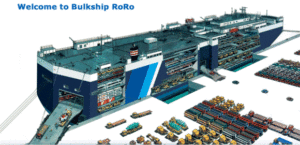
Dry-bulk ships
Designed for the carriage of ore, coal, grain, and the like, dry-bulk ships bear a superficial likeness to container ships since they often have no cargo handling gear and, unlike the tanker, have large cargo hatches. The absence of containers on deck is a decisive indicator that a vessel is a dry-bulk ship, but an observer may be deceived by the occasional sight of a dry-bulk ship carrying containers and other nonbulk cargo on deck. An incontrovertible indicator is the self-unloading gear, usually a large horizontal boom of open trusswork, carried by some bulk ships. On the Great Lakes of North America this gear is a near-universal feature of ships built since 1960.
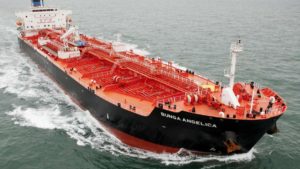
General cargo ship
The once-ubiquitous general cargo ship continues to be built, though in modest numbers. Those built in the last third of the 20th century are usually fitted with deck cranes, which give them an appearance distinct from the more-specialized ship types.
